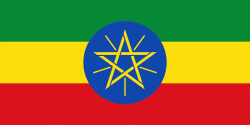Bale Zone (Bale)
Bale Zone (Oromo: Aaana Baalee) is a zone in Oromia Region of Ethiopia. Bale is bordered on the south by the Ganale Dorya River which separates it from Guji Zone, on the west by the West Arsi Zone, on the north by Arsi Zone, on the northeast by the Shebelle River which separates it from West Hararghe Zone and East Hararghe Zone, and on the east by the Somali Region.
The highest point in the Bale Zone, and also the highest point in Oromia, is Mount Batu (4,307 m) in the Urgoma Mountains range. Other notable peaks of the Urgoma include Mount Tullu Dimtu, Mount Darkeena and Mount Gaysay. Rivers include the Wab and the Waab; notable lakes include Garba Guracha and Hora Orgona. Bale zone is connected with neighboring zones and region by national highway. It is connected with Finfinne via Robe highway. The economy of the zone is mainly dominated by agriculture. The zone is for coffee and wheat production. Points of interest in the Zone include Sheikh Hussein—named for the tomb of a Muslim saint—the Bale Mountains National Park, and the Sof Omar Caves. Towns and cities in Bale include Dodola, Ginir, Goba and Robe.
Bale zone is the second largest zone in Oromia National Regional State after Borena zone with a total area of 63,555 km2. It shares about 17.5% of total area of Oromia. It has 18 districts, 2 urban administrative centers, 20 urban kebeles and 351 rural kebeles.
The Central Statistical Agency (CSA) reported that 5,130 metric tons of coffee were produced in this zone in the year ending in 2005, based on inspection records from the Ethiopian Coffee and Tea authority. This represents 4.46% of the Region's output and 2.2% of Ethiopia's total output.
The highest point in the Bale Zone, and also the highest point in Oromia, is Mount Batu (4,307 m) in the Urgoma Mountains range. Other notable peaks of the Urgoma include Mount Tullu Dimtu, Mount Darkeena and Mount Gaysay. Rivers include the Wab and the Waab; notable lakes include Garba Guracha and Hora Orgona. Bale zone is connected with neighboring zones and region by national highway. It is connected with Finfinne via Robe highway. The economy of the zone is mainly dominated by agriculture. The zone is for coffee and wheat production. Points of interest in the Zone include Sheikh Hussein—named for the tomb of a Muslim saint—the Bale Mountains National Park, and the Sof Omar Caves. Towns and cities in Bale include Dodola, Ginir, Goba and Robe.
Bale zone is the second largest zone in Oromia National Regional State after Borena zone with a total area of 63,555 km2. It shares about 17.5% of total area of Oromia. It has 18 districts, 2 urban administrative centers, 20 urban kebeles and 351 rural kebeles.
The Central Statistical Agency (CSA) reported that 5,130 metric tons of coffee were produced in this zone in the year ending in 2005, based on inspection records from the Ethiopian Coffee and Tea authority. This represents 4.46% of the Region's output and 2.2% of Ethiopia's total output.
Map - Bale Zone (Bale)
Map
Country - Ethiopia
 |
 |
| Flag of Ethiopia | |
Anatomically modern humans emerged from modern-day Ethiopia and set out to the Near East and elsewhere in the Middle Paleolithic period. Southwestern Ethiopia has been proposed as a possible homeland of the Afroasiatic language family. In 980 BCE, the Kingdom of D'mt extended its realm over Eritrea and the northern region of Ethiopia, while the Kingdom of Aksum maintained a unified civilization in the region for 900 years. Christianity was embraced by the kingdom in 330, and Islam arrived by the first Hijra in 615. After the collapse of Aksum in 960, a variety of kingdoms, largely tribal confederations, existed in the land of Ethiopia. The Zagwe dynasty ruled the north-central parts until being overthrown by Yekuno Amlak in 1270, inaugurating the Ethiopian Empire and the Solomonic dynasty, claimed descent from the biblical Solomon and Queen of Sheba under their son Menelik I. By the 14th century, the empire grew in prestige through territorial expansion and fighting against adjacent territories; most notably, the Ethiopian–Adal War (1529–1543) contributed to fragmentation of the empire, which ultimately fell under a decentralization known as Zemene Mesafint in the mid-18th century. Emperor Tewodros II ended Zemene Mesafint at the beginning of his reign in 1855, marking the reunification and modernization of Ethiopia.
Currency / Language
| ISO | Currency | Symbol | Significant figures |
|---|---|---|---|
| ETB | Ethiopian birr | Br | 2 |
| ISO | Language |
|---|---|
| AM | Amharic language |
| EN | English language |
| OM | Oromo language |
| SO | Somali language |
| TI | Tigrinya language |















